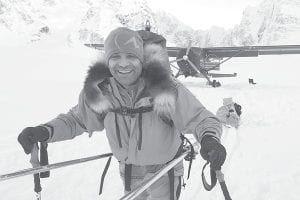After a gloomy 10-day wait on the weather in Talkeetna, Alaska, Lonnie Dupre was all smiles after landing at his base camp on Kahiltna Glacier on January 8. Located at 7,200 feet, Kahiltna Glacier serves as Dupre’s base camp as he begins his third attempt at summiting Mount Denali in January. If he makes it, he will become the first solo person to climb to the top of the 20,320 mountain in January, the coldest, darkest month of the year.

A dither, a dather, a too warm winter in Talkeetna, Alaska was turning Lonnie Dupre’s plans all a blather as he patiently waited for the weather to clear so he could begin his third attempt at climbing Mount McKinley (Denali) in January, the darkest, coldest month of the year on the mountain.
Wondering whether the wimpy weather was ever going to clear was getting to be a wearing question for Dupre, who had been waiting anxiously since December 29 to begin his third climbing attempt. Finally a break in the low hanging clouds on Tuesday, January 8, allowed Dupre to fly to his base camp on Kahiltna Glacier at the base of Denali. Here he began what he (and many hope) will be a successful climb to the top of the 20,320-foot mountain.
This time out Dupre is carrying 34 days worth of supplies. During the past two attempts Dupre was stuck in small snow caves for about one week and each time he ran too low on supplies to keep heading up the mountain. Dupre spends about two hours per day digging small caves to sleep in because the mountain winds are too strong for any tent to survive in.
As he climbs Dupre will have to stop and take rest days to get acclimated to the thin air. He will pull a sled loaded with about 150 pounds of gear and carry another 50 pounds of supplies in his backpack. He will walk or ski with the sled until he reaches 14,200 feet, and then he will leave it behind as he begins the more technical part of his climb.
The higher he goes the windier and colder it will get. In the past he has battled winds that exceeded 100 miles per hour and temperatures lower then -60 F. Most of the hiking/climbing Dupre will do will be in low light or by moonlight; there are only six hours of daylight on the mountain in January.
Two winters ago Dupre made it to 17,200 feet before he was trapped for almost one week in a snow cave by savage weather. Last year he made it as high as 15,700 feet but was stranded again for a week in a snow cave at 14,200 and again was too weak and too short on supplies to continue.
The winter climb on Denali is dangerous. So far only 16 people have reached Denali’s summit in the winter and six deaths occurred during those climbs. Only one team of three Russians has ever climbed to the top of Denali in January, and only four people have gone alone to the top, but none in January.
To make it, Dupre will have to rely on his experiences gained over 25 years of Arctic exploration. He has traveled twice to the North Pole and spent parts of three years with a partner from Australia to become the first people to circumvent Greenland by non-motorized transport.
As he goes upward Dupre will keep a journal and take pictures for a documentary film called Cold Love he hopes will help illuminate the problems global warming is causing to the Polar Regions. The documentary will be funded by donations collected by the website kickstarter.com.
“Snow and ice are important in our polar regions because they help reflect the sun’s energy back into space, “ Dupre said, adding, “Basically, the planet’s polar regions act as a thermostat to keep our planet cool.”
Dupre said he feels well prepared for this climb. “The experience you gain from each expedition and climb significantly reduces the risk because you understand the route more intimately and can fine tune your equipment accordingly. So this year I’m more confident because I’m traveling lighter and more efficiently. Now it’s up to the weather!”


Loading Comments